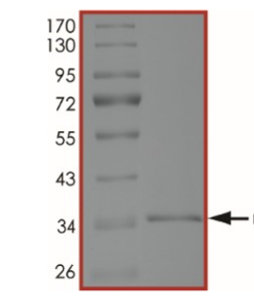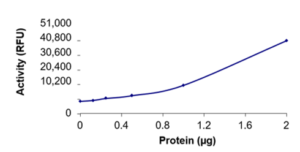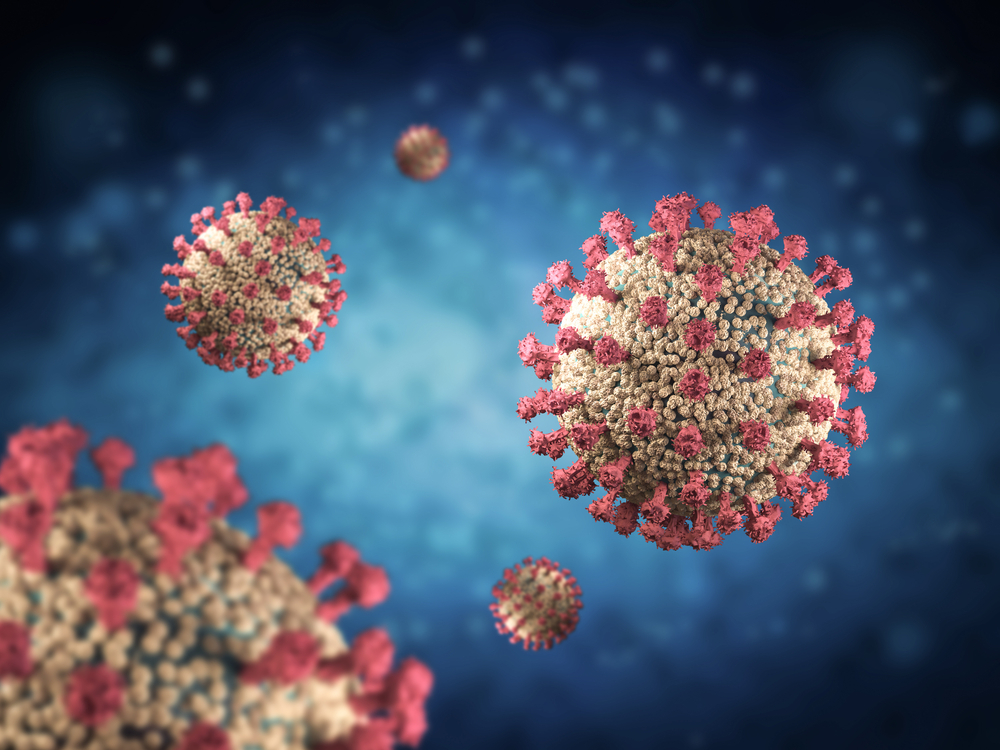
SDS-PAGE: The purity was determined to be >90% by densitometry. MW ~35 kDa.

Activity: The protease specific activity of 3CLpro was determined to be 4170 pmol/min/mg at an enzyme concentration of 1.2 µM.
SARS-CoV-2 3C-Like Proteinase (3CLpro), Active
Price range: $960.64 through $1,355.82 excl. VAT
Active recombinant full-length SARS-CoV-2 3CLpro, part of the large replicase polyprotein 1ab (S3264-Q3569), expressed in E. coli cells with an N-terminal His-tag. SARS-CoV-2, previously known as the 2019 Novel Coronavirus (2019-nCoV), causes the pandemic COVID-19 disease.
SARS-COV-2 3C-LIKE PROTEINASE (3CLpro), ACTIVE
Active recombinant full-length SARS-CoV-2 3C-Like Proteinase (3CLpro), part of the large replicase polyprotein 1ab (S3264-Q3569), expressed in E. coli cells with an N-terminal His-tag. SARS-CoV-2, previously known as the 2019 Novel Coronavirus (2019-nCoV), causes the pandemic COVID-19 disease.
PRODUCT DETAILS – SARS-COV-2 3C-LIKE PROTEINASE (3CLpro), ACTIVE
- Active recombinant full-length 2019-nCoV 3CLpro.
- Expressed in E. coli cells with an N-terminal His-tag and >90% purity.
- Presented as liquid in 50mM sodium phosphate, pH7.5, 300mM NaCl, 200mM imidazole, 1mM DTT, 10% glycerol.
- Protease specific activity of 3CLpro was determined to be 4170 pmol/min/mg at an enzyme concentration of 1.2 µM.
BACKGROUND
In December 2019 a novel coronavirus, severe acute respiratory syndrome coronavirus 2 (SARS-CoV-2), formerly known as the 2019 novel coronavirus (2019-nCoV) was identified in Wuhan, China, causing a world-wide pandemic. Three coronaviruses, SARS-CoV, MERS-CoV, and SARS-CoV-2 have been identified as being a highly pathogenic for humans, and there is currently no effective antiviral treatment. Therefore, studies are focused on rapid development of vaccines and antiviral drugs to prevent and treat coronavirus infection. There are several potential strategies to pharmacologically fight against the disease (COVID-19), including vaccines, monoclonal antibodies, oligonucleotide-based therapies, peptides, interferon therapies, and small-molecule drugs (Dömling & Gao, 2020).SARS-CoV-2 3C-like proteinase (3CLpro) is the nonstructural protein number 5, also a cysteine protease, that is released from the virally encoded polyprotein by extensive proteolytic processing. The 3CLpro cleaves the C-terminus of the large replicase polyprotein 1ab (~790 kDa) at no fewer than 11 sites (Hegyi et al., 2002). Inhibiting the activity of this enzyme would block viral replication (Zhang et al., 2020). The functional importance of 3CLpro in the viral life cycle makes this protease an attractive target for the development of drugs directed against SARS and other coronavirus infections (Anand et al., 2003).
REFERENCES
- Anand K. et al., Coronavirus main proteinase (3CLpro) structure: Basis for design of anti-SARS drugs. Science. 2003, 300:1763-1767.
- Dömling A, Gao L. Chemistry and Biology of SARS-CoV-2. Chem. 2020;6(6):1283-1295.
- Hegyi, A. et al., Conservation of substrate specificities among coronavirus main proteases. J Gen Virol. 2002,83:595-599.
- Zhang L. et al., Crystal structure of SARS-CoV-2 main protease provides a basis for design of improved α-ketoamide inhibitors. Science. 2020, 368:409-412.

